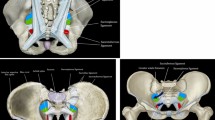Abstract
Risk of intraoperative neuropathic injury in minimally invasive surgery has been established as a leading complication. Continuous intraoperative neuromonitoring (IONM), such as upper extremity somatosensory evoked potentials (ueSSEPs), to decrease peripheral nerve injury due to positional stress has been described. Robotic-assisted laparoscopic prostatectomy (RALP) requires steep Trendelenberg, which may predispose patients to upper extremity neuropraxia. Subdermal stimulating electrodes were placed on the patients’ bilateral wrists over the ulnar nerve and the nerve was stimulated. Realtime waveforms were compared to baseline data to prevent and detect injury to the ulnar nerve. Established intervention criteria, indicating risk for neuropathic damage necessitating intraoperative patient repositioning, was a 50% loss in amplitude or a 10% increase in latency. One hundred and forty three patients received RALP with IONM. 17 of 143 patients (11.8%) met ueSSEP intervention criteria. Only weight was significantly different between the two groups (p = 0.04). Mean reduction in amplitude was 79.9% (SE 4.1). Average amplitude loss duration was 22 min (SE 4.0). Weight and BMI were correlated to the degree of amplitude reduction (p = 0.03 and < 0.01), while operative time and DM approached significance (p = 0.09 and p = 0.14). This is the first study to use IONM to reduce the risk of nerve injury during genitourinary surgery. Realtime nerve monitoring using ueSSEP allowed for upper extremity intraoperative monitoring and repositioning. This may decrease the risk of upper extremity neuropraxia due to malpositioning during RALP. Weight and BMI were identified as risk factors for possible nerve injury. Further data collection and analysis to preoperatively stratify patients for application of IONM during RALP is currently ongoing.



Similar content being viewed by others
Abbreviations
- RALP:
-
Robotic-assisted laparoscopic prostatectomy
- IONM:
-
Intraoperative neuromonitoring
- ueSSEPs:
-
Upper extremity somatosensory evoked potentials
- N20:
-
Cortical
References
Kroll DA, Caplan RA, Posner K, Ward RJ, Cheney FW (1990) Nerve injury associated with anesthesia. Anesthesiology 73:202–207
Chung I et al (2009) Upper-limb somatosensory evoked potential monitoring in lumbosacral spine surgery: a prognostic marker for position-related ulnar nerve injury. Spine J 9:287–295
Schwartz DM, Drummond DS, Hahn M, Ecker ML, Dormans JP (2000) Prevention of positional brachial plexopathy during surgical correction of scoliosis. J Spinal Disord 13:178–182
Schwartz DM et al (2006) Neurophysiological identification of position-induced neurologic injury during anterior cervical spine surgery. J Clin Monit Comput 20:437–444
Toleikis JR (2005) Intraoperative monitoring using somatosensory evoked potentials: a position statement by the american society of neurophysiological monitoring. J Clin Monit Comput 19:241–258
Positioning in anesthesiology: toward a better understanding of stretch-induced perioperative neuropathies | anesthesiology | ASA Publications. Available at: https://anesthesiology.pubs.asahq.org/article.aspx?articleid=1943947. Accessed 22 May 2019
Akhavan A, Gainsburg DM, Stock JA (2010) Complications associated with patient positioning in urologic surgery. Urology 76:1309–1316
Wechter ME, Kho RM, Chen AH, Magrina JF, Pettit PD (2013) Preventing slide in trendelenburg position: randomized trial comparing foam and gel pads. J Robot Surg 7:267–271
Winfree CJ, Kline DG (2005) Intraoperative positioning nerve injuries. Surg Neurol 63:5–18 (Discussion 18)
Scarpato K et al (2011) 1109 Extremity peripheral nerve injuries following robotic prostatectomy (ralp). J Urol 185(4):e446
Mills JT et al (2013) Positioning injuries associated with robotic assisted urological surgery. J Urol 190:580–584
Gezginci E et al (2015) Postoperative pain and neuromuscular complications associated with patient positioning after robotic assisted laparoscopic radical prostatectomy: a retrospective non-placebo and non-randomized study. Int Urol Nephrol 47:1635–1641
Nuwer MR, Dawson EG, Carlson LG, Kanim LE, Sherman JE (1995) Somatosensory evoked potential spinal cord monitoring reduces neurologic deficits after scoliosis surgery: results of a large multicenter survey. Electroencephalogr Clin Neurophysiol 96:6–11
Author information
Authors and Affiliations
Corresponding author
Ethics declarations
Conflict of interest
The following authors have no conflict of interest (both personal and institutional): Matthew J. Watson, Michael Tonzi, Raymond Xu, Gregory Heath, Amar Singh. The following authors are employed by Medsurant Health: Brandon Koch, Brandon Lute.
Human and animal rights statement
No animals were used in this study, only consented adult male humans.
Informed consent
Informed consent was given by all participants prior to the surgery to undergo intraoperative neuromonitoring.
Additional information
Publisher's Note
Springer Nature remains neutral with regard to jurisdictional claims in published maps and institutional affiliations.
Rights and permissions
About this article
Cite this article
Watson, M.J., Koch, B., Tonzi, M. et al. Decreasing the prospect of upper extremity neuropraxia during robotic assisted laparoscopic prostatectomy: a novel technique. J Robotic Surg 14, 733–738 (2020). https://doi.org/10.1007/s11701-020-01047-w
Received:
Accepted:
Published:
Issue Date:
DOI: https://doi.org/10.1007/s11701-020-01047-w




